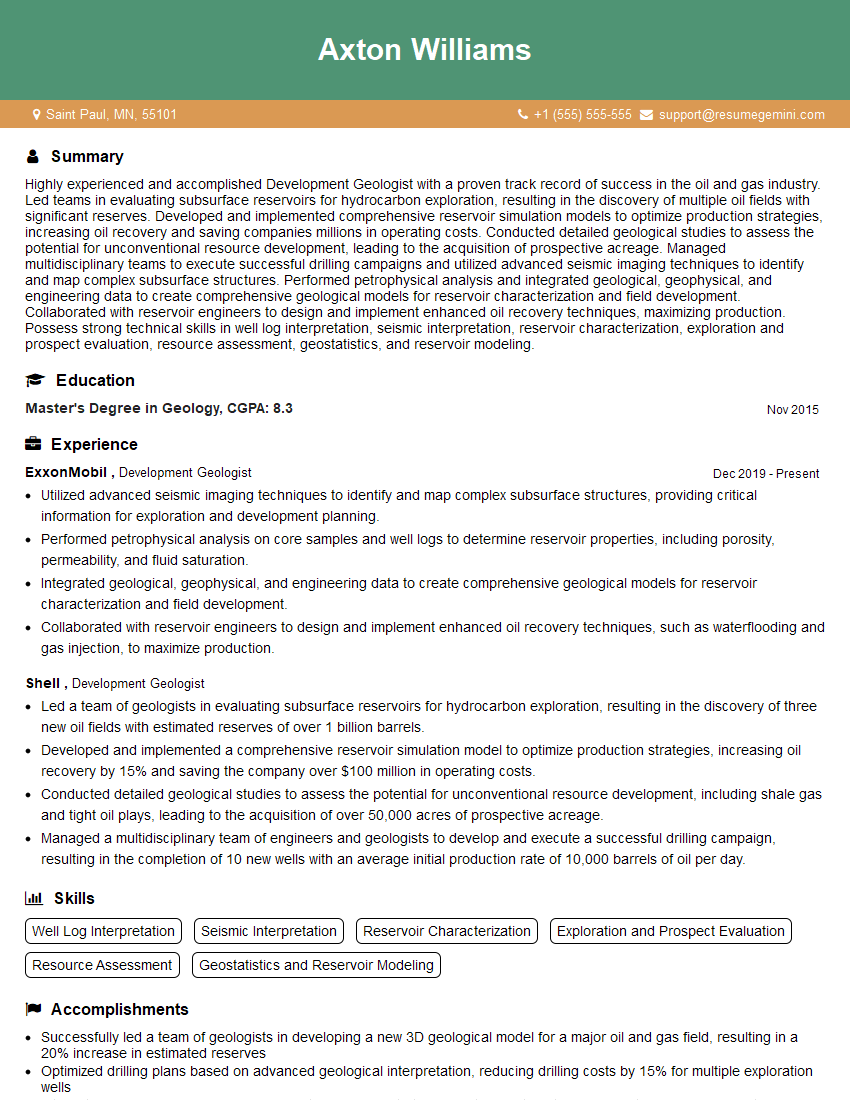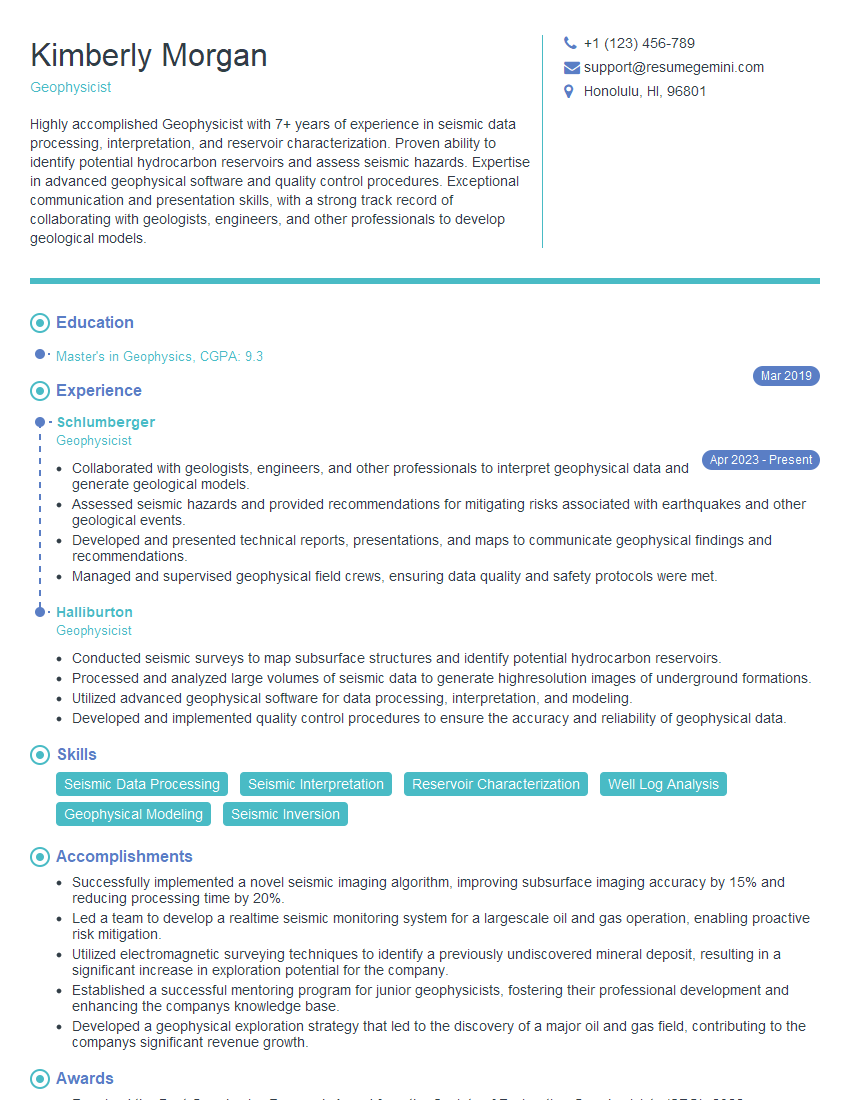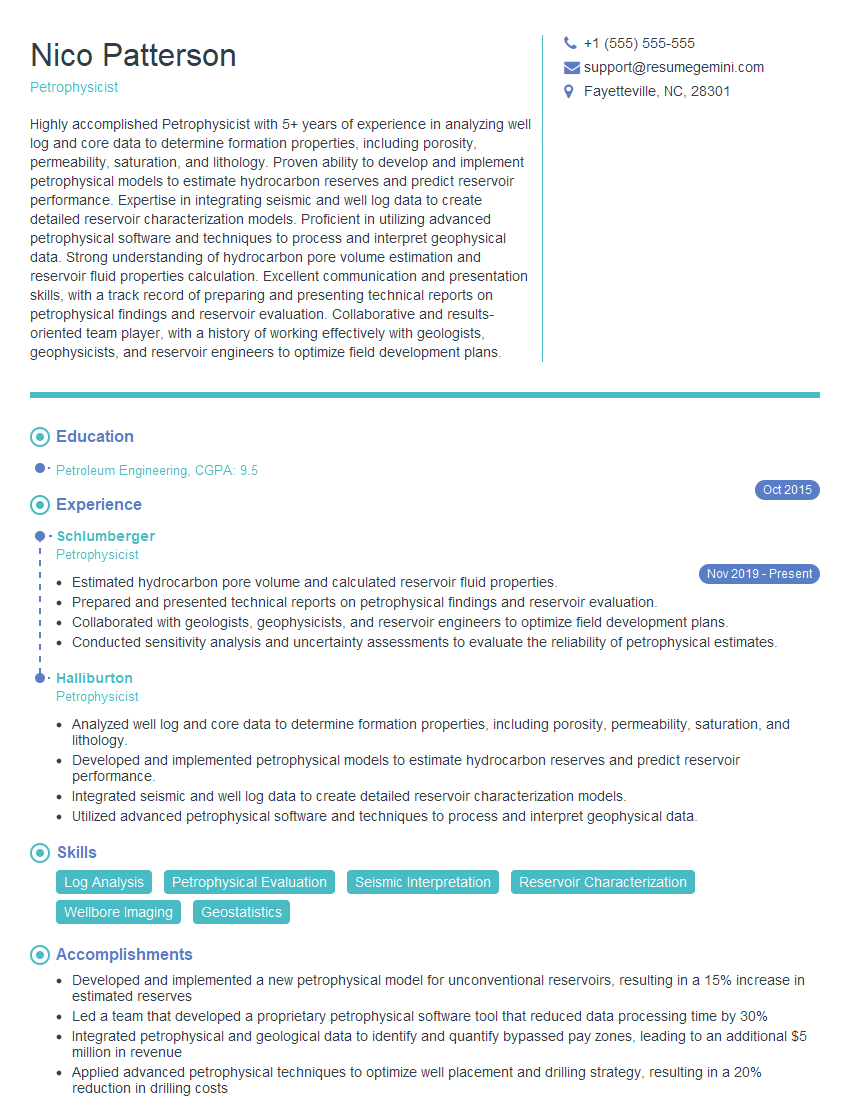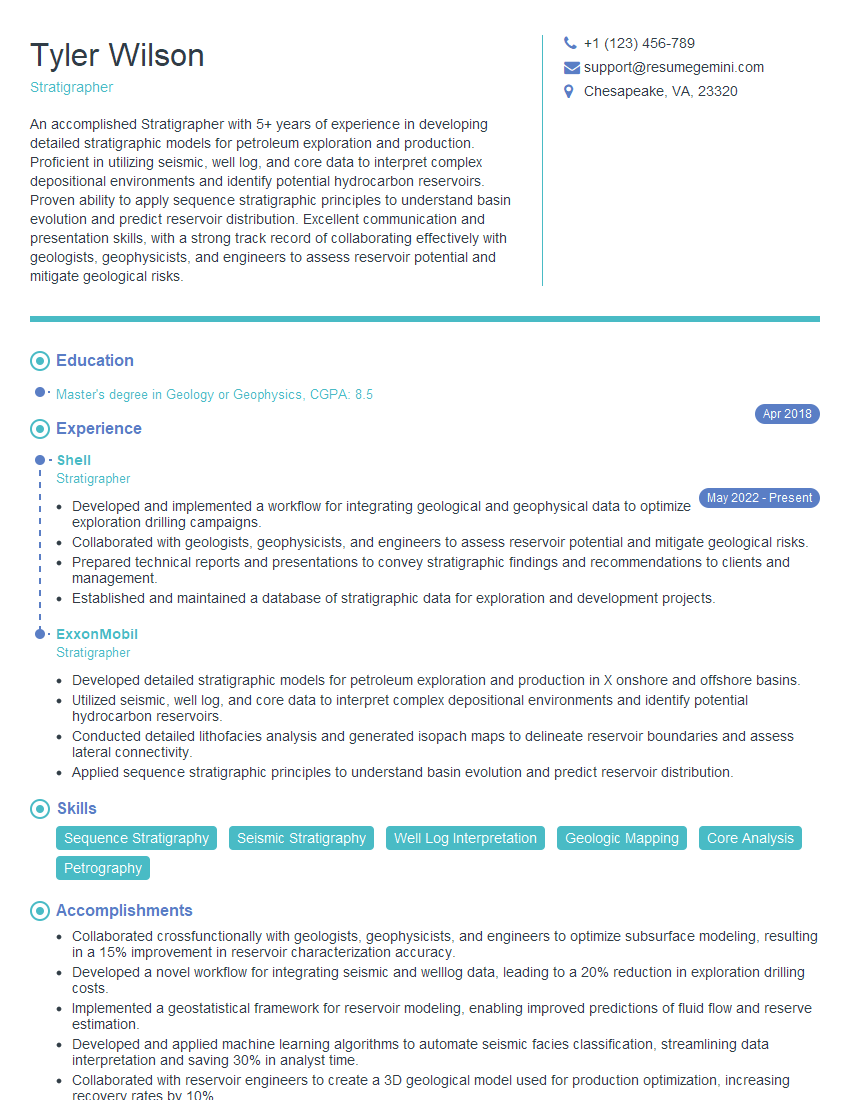Are you ready to stand out in your next interview? Understanding and preparing for Reservoir Fluvial Systems Analysis interview questions is a game-changer. In this blog, we’ve compiled key questions and expert advice to help you showcase your skills with confidence and precision. Let’s get started on your journey to acing the interview.
Questions Asked in Reservoir Fluvial Systems Analysis Interview
Q 1. Describe the key characteristics of fluvial reservoir systems.
Fluvial reservoir systems, formed by rivers and streams, are characterized by their heterogeneity and complex geometries. Imagine a river constantly shifting its course, depositing sediment in layers. This creates a reservoir with varying rock types, permeabilities, and porosities. Key characteristics include:
- Layered architecture: Sediments are deposited in distinct layers reflecting changes in river energy and sediment supply.
- Channel-form geometries: Sandstones representing former river channels are typically encased in finer-grained materials like shales or mudstones.
- Variable reservoir properties: Permeability and porosity vary significantly depending on the sediment type and depositional environment (e.g., channel fill vs. floodplain).
- Lateral and vertical heterogeneity: The reservoir’s properties change significantly both horizontally and vertically, making accurate modeling challenging.
- Presence of multiple facies: Fluvial systems encompass various sedimentary facies, reflecting different depositional environments within the river system (e.g., channel, levee, floodplain).
Understanding these characteristics is crucial for efficient reservoir management and production optimization.
Q 2. Explain the difference between braided and meandering fluvial systems.
Braided and meandering fluvial systems represent distinct river styles, resulting in different reservoir architectures. Think of braided rivers as a multitude of interweaving, shallow channels, like a constantly shifting network of streams, while meandering rivers are characterized by a single, sinuous channel that wanders across a floodplain.
- Braided rivers: High sediment load, steep gradients, and unstable channels lead to numerous, relatively short-lived channels, creating a reservoir with abundant, but often discontinuous, sandstone bodies. They tend to have coarser-grained sediments.
- Meandering rivers: Lower sediment load, gentler gradients, and a more stable channel produce a single, meandering channel with well-defined point bars (inside bends), cut banks (outside bends), and extensive floodplains. Reservoirs from meandering rivers show longer, more continuous sandstone bodies with a better-defined geometry.
The choice of reservoir modeling technique needs to accommodate this architectural difference; braided systems might require stochastic modeling to represent the chaotic channel distribution, whereas meandering systems are often better suited to deterministic models.
Q 3. How do you identify fluvial depositional environments from well logs?
Identifying fluvial depositional environments from well logs relies on recognizing characteristic patterns in log responses. We’re essentially looking for a ‘fingerprint’ left by the sediments. Key indicators include:
- Gamma ray logs: High gamma ray readings typically indicate shales (floodplain deposits), while lower values suggest sandstones (channel deposits).
- Resistivity logs: High resistivity values are often indicative of porous and permeable sandstones, while low values suggest less permeable shales and mudstones.
- Neutron porosity logs: These logs can help differentiate between sandstone and shale based on their porosity differences.
- Density logs: Density logs aid in lithological identification, assisting in separating sandstones from shales based on their density contrast.
By analyzing the vertical and lateral changes in these log responses, we can infer the sequence of depositional environments and build a geological model of the reservoir. For example, a cyclical pattern of high and low gamma ray values might indicate the repeated deposition of channel and floodplain facies.
Q 4. What are the common reservoir quality indicators in fluvial systems?
Reservoir quality in fluvial systems is primarily controlled by the characteristics of the sedimentary rocks forming the reservoir. Key indicators include:
- Porosity: The void space within the rock, crucial for hydrocarbon storage. Higher porosity usually translates to better reservoir quality.
- Permeability: The interconnectedness of the pore spaces, allowing for fluid flow. High permeability facilitates hydrocarbon production.
- Grain size: Coarser-grained sandstones (e.g., those deposited in channels) typically have higher porosity and permeability than finer-grained sediments.
- Sorting and cementation: Well-sorted sandstones with minimal cementation tend to exhibit better reservoir properties.
- Clay content: High clay content can reduce porosity and permeability, negatively impacting reservoir quality.
Analysis of core samples, well logs, and thin sections is critical for assessing these parameters and characterizing reservoir quality. A well-sorted, coarse-grained sandstone with low clay content and minimal cementation would be considered an excellent reservoir.
Q 5. Explain how facies analysis is used in fluvial reservoir characterization.
Facies analysis is the cornerstone of fluvial reservoir characterization. It involves identifying and interpreting different sedimentary facies (rock types and their properties) to reconstruct the depositional environment and predict reservoir architecture. Imagine creating a detailed map of the ancient river system by examining the different rock types.
The process includes:
- Data acquisition: Gathering data from cores, well logs, and seismic surveys.
- Facies identification: Classifying different rock types based on their sedimentary structures, grain size, and composition.
- Facies association: Determining the spatial relationships between different facies to understand their depositional context.
- Facies modeling: Creating a three-dimensional model of the reservoir based on the identified facies and their relationships.
This detailed understanding of the reservoir’s heterogeneity is essential for optimizing well placement, predicting production performance, and managing reservoir fluids effectively.
Q 6. Describe different types of fluvial architectural elements.
Fluvial architectural elements are the building blocks of the reservoir, reflecting the different depositional units formed by the river. These elements can be categorized as:
- Channel fills: Sandstone bodies representing the former river channels, typically displaying cross-bedding or other sedimentary structures indicative of flow.
- Levees: Natural embankments built up along the river channel, often consisting of finer-grained sediments than the channel fills.
- Floodplains: Flat areas adjacent to the river that are flooded during high water, typically composed of finer-grained sediments like mudstones and siltstones.
- Crevasse splays: Sediment deposits formed by the breaching of levees during floods, characterized by relatively thin, sheet-like sandstone bodies.
- Point bars: Crescent-shaped deposits formed on the inside bends of meandering rivers, usually composed of well-sorted sand and gravel.
Understanding the geometry, distribution, and connectivity of these elements is crucial for predicting reservoir performance. For instance, the presence of numerous interconnected channel fills would indicate a potentially high-permeability reservoir.
Q 7. How do you determine the net-to-gross ratio in a fluvial reservoir?
The net-to-gross ratio (NtG) represents the proportion of reservoir rock (net) to the total thickness of the rock sequence (gross) in a reservoir. Essentially, it’s the fraction of the reservoir that is actually productive. Imagine a layer cake: the net is the delicious cake layers, and the gross includes the icing and the cardboard base – not all is productive.
Determining NtG in a fluvial reservoir involves:
- Identifying reservoir and non-reservoir units: Determining which parts of the sequence are permeable enough to contribute to hydrocarbon production (net) and which parts are impermeable (gross).
- Analyzing well logs: Using gamma ray, resistivity, and porosity logs to identify the reservoir and non-reservoir intervals.
- Core analysis: Examining core samples to directly measure reservoir properties and confirm log interpretations.
- Calculating the ratio: The NtG is calculated by dividing the total thickness of the reservoir units (net) by the total thickness of the entire sequence (gross).
The NtG is a crucial parameter for assessing the overall reservoir quality and is a key input for volumetric calculations and reserve estimations. A high NtG indicates a better reservoir with a greater volume of productive rock.
Q 8. Explain the concept of reservoir connectivity in fluvial systems.
Reservoir connectivity in fluvial systems refers to the degree to which different parts of a reservoir are interconnected, allowing for the flow of fluids (oil, gas, water) between them. Imagine a river delta; some channels are well-connected, allowing easy flow, while others might be isolated or poorly connected, acting as compartments. This connectivity significantly impacts reservoir performance, particularly during production. High connectivity enables efficient fluid drainage, while poor connectivity can lead to bypassed hydrocarbons and reduced recovery. We analyze connectivity using various techniques like network analysis of channel geometries, evaluating facies distribution, and through dynamic reservoir simulation that incorporates permeability and pressure data.
For instance, a highly connected reservoir might exhibit a homogeneous pressure distribution during production, indicating efficient fluid flow. In contrast, a poorly connected reservoir could show significant pressure variations within different compartments, indicating bypassed oil.
Q 9. What are the challenges in reservoir modeling of fluvial systems?
Modeling fluvial reservoirs presents several significant challenges. The most prominent is the inherent heterogeneity: fluvial systems are characterized by complex, unpredictable variations in reservoir properties like permeability and porosity across the reservoir. These variations occur at various scales, from centimeter-scale changes within individual sedimentary units to kilometer-scale variations in channel architecture. Another challenge lies in the uncertainty in subsurface data; seismic imaging might not capture all the fine-scale details of the channel system, and well data is often sparsely distributed. Additionally, accurately representing the complex flow dynamics within these heterogeneous systems requires sophisticated numerical simulation techniques, which can be computationally expensive. Lastly, understanding and quantifying the impact of diagenetic processes (post-depositional alterations) on reservoir quality is crucial but often difficult due to limitations in data and understanding.
Q 10. How do you incorporate seismic data into fluvial reservoir modeling?
Seismic data plays a crucial role in characterizing the large-scale architecture of fluvial reservoirs before drilling. We use seismic attributes (e.g., amplitude, frequency, and wavelet characteristics) to identify and map major channel belts and their internal architectural elements. Seismic interpretation can delineate the boundaries of different facies, helping constrain the geological model. Advanced techniques such as pre-stack seismic inversion can provide estimates of rock properties like porosity and impedance, which can be used to calibrate and improve the reservoir model. These seismic-derived properties are then integrated with well log data and core measurements to create a more comprehensive reservoir model.
For instance, a strong amplitude anomaly on a seismic section might correspond to a thick, high-porosity channel sand. This information is integrated with well data to refine the geological model and predict reservoir properties in areas without wells.
Q 11. Discuss the impact of heterogeneity on fluid flow in fluvial reservoirs.
Heterogeneity significantly impacts fluid flow in fluvial reservoirs. Think of it like trying to pour water through a sponge with many holes of varying sizes. High-permeability zones (large holes) act as preferential flow paths, while low-permeability zones (small holes or solid areas) restrict flow. This uneven flow can lead to uneven pressure distributions, bypassed oil or gas pockets, and ultimately, reduced hydrocarbon recovery. The degree of heterogeneity influences sweep efficiency, which determines how effectively injected fluids (water or gas) displace the hydrocarbons during enhanced oil recovery operations. Highly heterogeneous reservoirs may exhibit fingered or preferential flow patterns, leading to reduced sweep efficiency.
Understanding and characterizing this heterogeneity is crucial for effective reservoir management and optimizing production strategies. Techniques like geostatistics help to model and predict the spatial distribution of permeability, enabling more realistic simulations of fluid flow.
Q 12. Describe different methods for predicting reservoir permeability in fluvial systems.
Predicting permeability in fluvial reservoirs involves integrating various data sources and techniques. Empirical correlations using porosity and other well log data provide initial estimates. However, these correlations are often reservoir-specific and require calibration. Statistical methods like geostatistics (kriging) are used to interpolate permeability values between well locations, accounting for the spatial correlation of reservoir properties. Numerical simulation of fluid flow, calibrated to production data, helps to refine permeability estimates and assess their impact on reservoir performance. Finally, machine learning techniques are increasingly being used to build predictive models from large datasets, including seismic attributes, core data, and well logs, to provide a more precise permeability distribution.
Q 13. Explain how to use core data to characterize fluvial reservoir properties.
Core data provides invaluable information for characterizing fluvial reservoir properties at a fine scale. Core samples are analyzed to measure porosity, permeability, grain size distribution, and mineralogy. These measurements help to define different facies (e.g., channel sands, overbank fines) and their associated properties. Detailed analysis of core samples can reveal features like sedimentary structures (cross-bedding, laminations), which are critical for understanding depositional processes and predicting reservoir architecture. Special core analysis (SCAL) techniques provide data on relative permeability, capillary pressure, and wettability, which are crucial for simulating fluid flow in the reservoir. By integrating core data with other data sources, a more realistic and reliable reservoir model can be developed.
For instance, the analysis of core samples might reveal a particular facies to have high porosity and permeability, indicative of a preferential flow pathway. This information is critical for optimizing well placement and production strategies.
Q 14. What are the common types of traps found in fluvial reservoirs?
Fluvial reservoirs can contain various types of traps that accumulate hydrocarbons. Stratigraphic traps are common, where permeability changes within the fluvial system act as seals. For example, a low-permeability shale overlying a high-permeability channel sand can create a trap. Structural traps, formed by tectonic deformation, are less common in fluvial systems but can still be present. These could be faults that seal off a section of the reservoir or folds that create a structural high. Combination traps are also possible, where stratigraphic and structural elements combine to create a hydrocarbon trap. Understanding the trapping mechanism is critical for predicting the location and size of hydrocarbon accumulations.
Q 15. How does the understanding of fluvial systems impact reservoir management decisions?
Understanding fluvial systems is paramount in reservoir management because it directly influences hydrocarbon exploration, production strategies, and overall field development plans. Fluvial systems, characterized by river and stream deposits, exhibit highly variable reservoir properties – a complex network of channels, sandbodies, and overbank deposits. This heterogeneity necessitates a detailed understanding of the system’s architecture to optimize well placement, predict reservoir connectivity, and manage water and gas production efficiently.
For instance, knowing the distribution of high-permeability channel sands allows for the strategic placement of production wells to maximize oil or gas recovery. Conversely, understanding the location of low-permeability shales helps in identifying potential barriers to fluid flow and planning effective water management strategies. Ignoring this heterogeneity can lead to suboptimal well placement, reduced production rates, and increased operational costs. In essence, a robust understanding of the fluvial system’s architecture is the key to unlocking its full potential.
Career Expert Tips:
- Ace those interviews! Prepare effectively by reviewing the Top 50 Most Common Interview Questions on ResumeGemini.
- Navigate your job search with confidence! Explore a wide range of Career Tips on ResumeGemini. Learn about common challenges and recommendations to overcome them.
- Craft the perfect resume! Master the Art of Resume Writing with ResumeGemini’s guide. Showcase your unique qualifications and achievements effectively.
- Don’t miss out on holiday savings! Build your dream resume with ResumeGemini’s ATS optimized templates.
Q 16. Explain the role of diagenesis in fluvial reservoir quality.
Diagenesis, the post-depositional alteration of sediments, plays a crucial role in determining the quality of fluvial reservoirs. Processes like compaction, cementation, and dissolution significantly impact reservoir porosity and permeability. Compaction reduces porosity by squeezing out pore fluids, while cementation fills pore spaces with minerals like calcite or quartz, further reducing porosity and potentially altering permeability. Dissolution, conversely, can enhance porosity by removing pre-existing cement or mineral grains.
For example, early cementation in a fluvial channel sand might significantly reduce permeability, making the reservoir less productive. Conversely, late-stage dissolution of carbonate cement could improve porosity and permeability. Understanding the diagenetic history of a reservoir is therefore critical in predicting its fluid flow characteristics and ultimately, its potential for hydrocarbon production. Detailed petrographic analysis and geochemical studies are essential for characterizing these diagenetic alterations.
Q 17. Describe the impact of different depositional processes on reservoir architecture.
Different depositional processes within fluvial systems create distinct reservoir architectures. Channel-fill deposits, formed by the migration of river channels, typically create lenticular, high-permeability sandbodies. Overbank deposits, laid down during floods in the areas surrounding channels, usually form lower-permeability mudstones or siltstones. These create complex reservoir architectures where highly productive channel sands are interspersed with less productive mudstones.
For instance, a meandering river system will exhibit a different architecture compared to a braided river system. Meandering rivers create relatively long, sinuous channel bodies, while braided rivers create multiple, interconnected channels with a more complex network of sandbodies. Understanding these different depositional processes is critical in predicting the three-dimensional distribution of reservoir properties and in building accurate geological models. This affects reservoir simulation and ultimately, production optimization.
Q 18. How do you interpret cross-sectional data from fluvial environments?
Interpreting cross-sectional data from fluvial environments requires a systematic approach. We begin by identifying key sedimentary features like channel bodies, point bars, and overbank deposits. The geometry and internal architecture of these features provide valuable information about the depositional environment and the flow regime. Key elements include identifying the thickness, lateral extent, and internal stratification of each unit. We also analyze facies changes to determine the environmental shifts during deposition.
For example, upward fining sequences suggest a decrease in flow energy, indicating a transition from channel to overbank environments. Conversely, upward coarsening sequences point to increasing flow energy, possibly due to channel incision. Using wireline logs (gamma ray, resistivity, neutron porosity) in conjunction with core data helps in identifying and characterizing these facies and their associated properties. Software packages are used to create three-dimensional models that integrate these data to understand the reservoir’s architecture.
Q 19. What software packages are commonly used for fluvial reservoir modeling?
Several software packages are widely used for fluvial reservoir modeling. These tools allow geoscientists to integrate data from various sources (seismic, well logs, core data) to create realistic geological models. Some of the most common packages include:
Petrel(Schlumberger): Offers a comprehensive suite of tools for reservoir modeling, including geocellular modeling, seismic interpretation, and reservoir simulation.RMS(Landmark): Provides powerful tools for seismic interpretation, geostatistical modeling, and reservoir simulation.Gocad(Paradigm): Is a robust software package used for 3D geological modeling, particularly useful for complex geological structures.Kingdom(IHS Markit): Provides tools for seismic interpretation, well log analysis, and reservoir modeling.
The choice of software depends on the specific project requirements and the data available. These packages generally allow for the creation of static models (representing the geological architecture) and dynamic models (simulating fluid flow and production).
Q 20. Explain the concept of sequence stratigraphy in fluvial systems.
Sequence stratigraphy provides a framework for understanding the architecture of fluvial systems on a larger scale. It examines the stacking patterns of sedimentary units in response to changes in relative sea level. Fluvial systems are strongly influenced by base-level changes; falling sea levels can lead to incision and the formation of valley fills, while rising sea levels can result in the deposition of finer-grained sediments.
By identifying sequence boundaries and systems tracts, we can understand the temporal and spatial relationships between different fluvial depositional units. This aids in predicting the distribution of reservoir sands and their connectivity. For example, identifying a highstand systems tract might indicate a period of widespread channel deposition with potentially high reservoir potential, while a lowstand systems tract might be characterized by incised valleys with limited reservoir continuity.
Q 21. Discuss the role of paleogeography in understanding fluvial reservoir distribution.
Paleogeography plays a vital role in understanding the distribution of fluvial reservoirs. Reconstructing the ancient geography, including the location of drainage basins, rivers, and sediment sources, is crucial for interpreting the spatial distribution of fluvial deposits. Factors such as topography, climate, and tectonic activity significantly influence the evolution of fluvial systems and their sedimentary architecture.
For example, knowing the location of a major mountain range during deposition helps in predicting the source of sediment and the potential location of major river systems. Understanding the paleoclimate allows us to predict the flow regime of the rivers (e.g., meandering vs. braided) and the type of sediments that were deposited. Therefore, integrating paleogeographic data with sedimentological data allows us to develop a more comprehensive understanding of fluvial reservoir distribution and improve exploration success.
Q 22. How do you quantify uncertainty in fluvial reservoir characterization?
Quantifying uncertainty in fluvial reservoir characterization is crucial because these systems are inherently heterogeneous. We don’t have perfect knowledge of subsurface geology. Uncertainty stems from limitations in data (e.g., sparse well logs, seismic ambiguity) and the inherent complexity of the depositional processes that form these reservoirs. We quantify this uncertainty using several methods:
- Probabilistic modeling: Instead of using single, best-guess values for parameters like porosity and permeability, we assign probability distributions to these properties. This reflects the range of possible values and their likelihoods. Monte Carlo simulations are often used to generate many reservoir realizations based on these distributions, allowing us to analyze the range of possible outcomes.
- Geostatistical methods: Techniques like kriging and sequential Gaussian simulation utilize spatial correlation in data to create multiple equally likely reservoir models. This helps visualize the spatial distribution of uncertainty.
- Sensitivity analysis: This identifies which parameters have the most significant impact on reservoir performance. Focusing on reducing uncertainty in these key parameters is more efficient than trying to refine estimates for less influential ones. For example, in a fluvial channel system, the location and geometry of the channels are usually much more influential than the precise grain size distribution within an individual channel.
- Ensemble modeling: Creating multiple reservoir models using different methods and assumptions. The range of predictions from these models represents the overall uncertainty.
For instance, imagine a fluvial reservoir with limited well data. We might use geostatistics to create several equally likely models showing varying channel locations and thicknesses. Each model would then be used in reservoir simulation to predict production, revealing the range of possible outcomes and quantifying the uncertainty associated with our prediction.
Q 23. Explain the application of geostatistics in fluvial reservoir modeling.
Geostatistics plays a vital role in bridging the gap between sparse data points and the need for a detailed reservoir model. Fluvial systems are inherently heterogeneous, with significant variations in reservoir properties over short distances. Geostatistical techniques enable us to create realistic 3D representations of these variations, even with limited data.
- Kriging: This interpolation method estimates values at unsampled locations based on the values at nearby sampled locations, considering the spatial correlation between them. It produces a smooth model, but can underestimate heterogeneity.
- Sequential Gaussian Simulation (SGS): This is a more advanced technique that honors the statistical distribution of the data while preserving the spatial variability. It creates multiple equally likely realizations of the reservoir model, capturing the uncertainty associated with the interpolation process. SGS is particularly useful for modeling fluvial channels due to its ability to reproduce complex geometries and high levels of heterogeneity.
- Stochastic modeling: Geostatistical methods are often used in conjunction with stochastic channel models to simulate the complex architecture of fluvial systems. These methods generate multiple realizations of the channel network, reflecting the inherent variability in fluvial deposition.
Imagine a scenario where you only have well logs from a few wells in a large fluvial reservoir. Geostatistical methods allow you to use the data from these wells to generate a comprehensive 3D model, accounting for the spatial correlation of reservoir properties and creating multiple realizations to represent the uncertainty. This model then forms the basis for reservoir simulation studies.
Q 24. Describe the use of production data in validating fluvial reservoir models.
Production data is essential for validating and calibrating fluvial reservoir models. A model that doesn’t match observed production behavior is unlikely to be accurate. Validation is done through history matching, a process where model parameters are adjusted to reproduce past production data. It’s not just about matching total production; it’s crucial to match the production profiles from individual wells and the overall reservoir performance over time.
- History matching: This iterative process involves adjusting model parameters (porosity, permeability, etc.) to minimize the difference between the simulated and observed production data. This ensures that the model accurately reflects the reservoir’s dynamic behavior.
- Production data analysis: Analyzing production data provides insights into reservoir connectivity, flow patterns, and the presence of barriers or compartmentalization within the fluvial system. These insights are vital in refining and adjusting reservoir models.
- Water cut analysis: Monitoring water production helps determine the extent of water encroachment and sweep efficiency, which are crucial parameters for validating reservoir models, especially in mature fields.
For example, if your model predicts significantly higher oil production than was actually observed, it suggests that your permeability values are overestimated or that you’ve missed key geological features. Similarly, a discrepancy between predicted and actual water cut profiles indicates an issue with the model’s representation of fluid flow.
Q 25. What are the key parameters used in reservoir simulation of fluvial systems?
Reservoir simulation of fluvial systems requires a suite of key parameters to accurately capture the complexity of these heterogeneous reservoirs. These parameters can be broadly classified into geological, petrophysical, and fluid properties.
- Geological parameters: These define the geometry and architecture of the reservoir. Examples include channel dimensions (width, thickness, depth), sinuosity, spacing, and the distribution of channel types (e.g., braided vs. meandering). These are often determined by interpreting seismic data, well logs, and core analysis.
- Petrophysical parameters: These describe the rock’s properties and their impact on fluid flow. This includes porosity (the void space in the rock), permeability (the rock’s ability to allow fluids to flow), and their spatial distribution. These are typically obtained from well logs and core analysis.
- Fluid properties: These define the characteristics of the fluids in the reservoir (oil, water, and gas). This includes viscosity, density, and relative permeability (the ability of each fluid to flow through the rock in the presence of other fluids). These can be determined from laboratory analysis of produced fluids.
- Fault and fracture parameters: If present, their geometry, permeability, and sealing properties need to be incorporated, as faults can significantly impact fluid flow in fluvial reservoirs.
Accurately characterizing these parameters is vital for reliable simulation results. Neglecting critical parameters, particularly the complex geometry of fluvial channels, can lead to inaccurate predictions of reservoir performance.
Q 26. How does the understanding of fluvial systems influence well placement strategies?
Understanding fluvial systems is paramount for effective well placement strategies. Fluvial reservoirs are characterized by highly variable permeability, with productive zones concentrated in channels and less permeable zones in overbank deposits. Poor well placement can lead to significant underperformance and wasted resources.
- Targeting high-permeability zones: Wells should be strategically placed within the highest-permeability channels to maximize production. Seismic interpretation and advanced geological modeling help identify these zones.
- Minimizing water production: Well placement needs to consider the distribution of water and oil within the reservoir to minimize water production and improve sweep efficiency. This often involves using techniques like horizontal drilling to target specific zones.
- Managing reservoir connectivity: Understanding how channels interconnect helps optimize well spacing and placement to efficiently drain the reservoir. Poorly placed wells might miss key portions of the reservoir, leading to bypassed oil.
- Considering reservoir compartmentalization: Fluvial systems can be compartmentalized by faults or low-permeability barriers. This needs to be accounted for when designing a well development plan, with well placement adjusted accordingly.
For example, in a meandering fluvial channel system, wells placed along the main channel trend will likely yield higher production compared to wells in the less permeable overbank areas. Furthermore, horizontal wells drilled along the channel axis may provide better drainage than vertical wells.
Q 27. Describe different methods for improving the recovery factor in fluvial reservoirs.
Improving the recovery factor in fluvial reservoirs requires a multifaceted approach, leveraging a deep understanding of the reservoir’s unique characteristics. Here are several methods:
- Improved reservoir characterization: More accurate geological models and improved quantification of uncertainties are vital. This involves integrating various data sources (seismic, well logs, core data) and employing advanced techniques like 3D seismic inversion and geostatistical modeling. This will help to pinpoint the most productive areas.
- Enhanced oil recovery (EOR) techniques: EOR methods can significantly boost recovery from fluvial reservoirs. These include:
- Waterflooding: Injecting water to displace oil towards production wells, improving sweep efficiency.
- Polymer flooding: Injecting polymers to increase water viscosity and improve sweep efficiency in heterogeneous reservoirs.
- Chemical flooding (e.g., surfactant or alkaline flooding): Injecting chemicals to reduce interfacial tension between oil and water, improving oil mobility.
- Gas injection (e.g., CO2 or N2 injection): Injecting gas to improve oil mobility and displace oil toward production wells.
- Optimized well placement and completion strategies: As discussed earlier, this involves placing wells strategically within the high-permeability channels and using techniques like horizontal drilling and multilateral wells to improve drainage and sweep efficiency.
- Intelligent completion techniques: These techniques, such as inflow control devices (ICDs), allow for better control of fluid flow within individual well completions, leading to more efficient reservoir drainage.
- Reservoir simulation and optimization: Sophisticated reservoir simulation models help predict the impact of different recovery strategies, allowing for optimization of field development plans to maximize recovery factor.
The choice of method will depend on reservoir characteristics, such as fluid properties, reservoir pressure, and the geological complexity of the fluvial system. A combination of methods might be necessary to achieve significant improvement in recovery factor.
Key Topics to Learn for Reservoir Fluvial Systems Analysis Interview
- Sediment Transport and Deposition: Understanding fluvial processes like bedload transport, suspended load, and the factors influencing sediment deposition within reservoirs. This includes exploring different empirical and numerical models.
- Reservoir Morphology and Hydrodynamics: Analyzing reservoir bathymetry, flow patterns, and their impact on sediment transport and deposition. Practical application includes predicting reservoir sedimentation rates and lifespan.
- Reservoir Sediment Management: Exploring strategies for mitigating negative impacts of sedimentation, such as dredging, sediment bypass, and reservoir operation optimization. This involves cost-benefit analysis and environmental considerations.
- Data Acquisition and Analysis: Familiarize yourself with techniques for collecting and interpreting reservoir data, including bathymetric surveys, sediment cores, and hydrological monitoring. This includes proficiency in data analysis software and statistical methods.
- Numerical Modeling and Simulation: Understanding and applying numerical models (e.g., 1D, 2D, 3D models) to simulate fluvial processes within reservoirs. This involves model calibration, validation, and interpretation of simulation results.
- Environmental Impact Assessment: Assessing the environmental consequences of reservoir sedimentation and management strategies, including impacts on water quality, aquatic ecosystems, and greenhouse gas emissions.
- Delta Formation and Evolution: Analyzing the formation and growth of deltas within reservoirs and their influence on reservoir capacity and water management.
Next Steps
Mastering Reservoir Fluvial Systems Analysis opens doors to exciting career opportunities in environmental consulting, water resource management, and research. To maximize your job prospects, it’s crucial to have a compelling resume that showcases your skills and experience effectively. Creating an ATS-friendly resume is key to getting noticed by potential employers. We highly recommend using ResumeGemini, a trusted resource, to build a professional and impactful resume tailored to the specific requirements of this field. Examples of resumes tailored to Reservoir Fluvial Systems Analysis are available to help guide you.
Explore more articles
Users Rating of Our Blogs
Share Your Experience
We value your feedback! Please rate our content and share your thoughts (optional).
What Readers Say About Our Blog
Take a look at this stunning 2-bedroom apartment perfectly situated NYC’s coveted Hudson Yards!
https://bit.ly/Lovely2BedsApartmentHudsonYards
Live Rent Free!
https://bit.ly/LiveRentFREE
Interesting Article, I liked the depth of knowledge you’ve shared.
Helpful, thanks for sharing.
Hi, I represent a social media marketing agency and liked your blog
Hi, I represent an SEO company that specialises in getting you AI citations and higher rankings on Google. I’d like to offer you a 100% free SEO audit for your website. Would you be interested?





